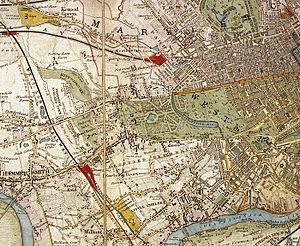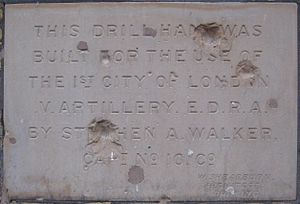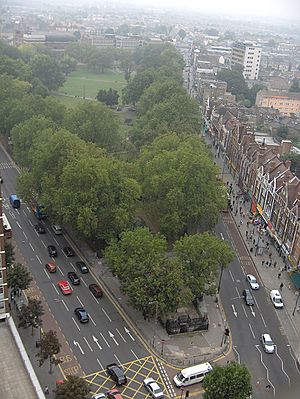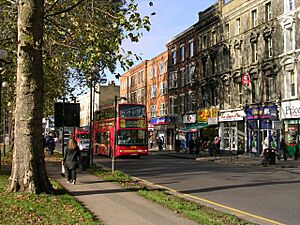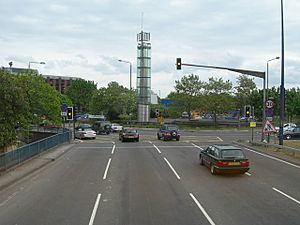Shepherd's Bush facts for kids
Quick facts for kids Shepherd's Bush |
|
|---|---|
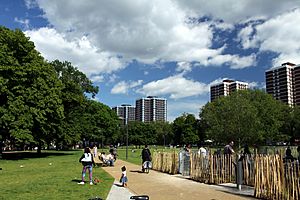 Shepherd's Bush Green |
|
| OS grid reference | TQ235798 |
| • Charing Cross | 4.9 mi (7.9 km) E |
| London borough | |
| Ceremonial county | Greater London |
| Region | |
| Country | England |
| Sovereign state | United Kingdom |
| Post town | LONDON |
| Postcode district | W12 |
| Dialling code | 020 |
| Police | Metropolitan |
| Fire | London |
| Ambulance | London |
| EU Parliament | London |
| UK Parliament |
|
| London Assembly | |
Shepherd's Bush is a lively area in West London, England. It's part of the London Borough of Hammersmith and Fulham. This area is about 7.9 kilometers (4.9 miles) west of Charing Cross, a famous spot in central London. It's known as an important city center in London.
Shepherd's Bush is mostly a place where people live. But it also has a busy shopping area called Shepherd's Bush Green. The huge Westfield London shopping center is just a short walk north. Main roads like Uxbridge Road, Goldhawk Road, and Askew Road are full of small, independent shops, pubs, and restaurants. If you love football, Loftus Road stadium is here. It's the home ground for Queens Park Rangers football club. In 2011, about 39,724 people lived in the area.
Shepherd's Bush is surrounded by other cool London areas. To the south is Hammersmith. To the east, you'll find Holland Park and Notting Hill. Harlesden and Kensal Green are to the north. And to the west are Acton and Chiswick. The northern part of Shepherd's Bush is known as White City. The area includes several local wards: Shepherd's Bush Green, Askew, College Park & Old Oak, and Wormholt and White City.
Contents
History of Shepherd's Bush
How Shepherd's Bush Got Its Name
The name Shepherd's Bush likely comes from its past use. This area was once open land where shepherds would rest their sheep. They were on their way to Smithfield Market in the City of London. Another idea is that it was named after a person who lived there. Records from 1635 show the area was called "Sheppard's Bush Green."
People have lived here since the Iron Age. Shepherd's Bush first appeared in written records in the year 704. It was bought by Waldhere, who was the Bishop of London. It was part of a larger estate called "Fulanham" back then.
Shepherd's Bush in the 1800s
A map from 1841 shows that Shepherd's Bush was mostly countryside. It had lots of open farmland. This was very different from Hammersmith, which was growing fast nearby. More homes started to be built in the late 1800s. London's population was growing quickly, and more places to live were needed. In 1904, a beautiful Catholic church was finished. It was called Holy Ghost and St Stephen. It was built in the Gothic style with red brick and Portland stone.
Shepherd's Bush in the 1900s
Like many parts of London, Shepherd's Bush was damaged during World War II. It was hit by V-1 flying bombs. These bombs were also called "doodlebugs" or "buzzbombs." They struck without much warning.
On April 13, 1963, the Beatles made their first-ever TV show for the BBC here. They recorded it at Lime Grove Studios in Shepherd's Bush. The band came back in 1964 to record again. Lime Grove Studios was later knocked down in 1994. New homes were built there instead.
More recently, the White City bus station was built. It's inside the old Dimco Buildings from 1898. These red brick buildings are very old and protected. They were first built as a shed for a London Underground power station. The Dimco buildings were used in movies too! They were the 'Acme Factory' in the 1988 film Who Framed Roger Rabbit. Later, they were the inside of the British Museum in The Mummy Returns.
Geography of Shepherd's Bush
The main part of the area is Shepherd's Bush Green. It's also called Shepherds Bush Common. This is a triangular area of about 8 acres (3.2 hectares) of open grass. It's surrounded by trees and roads with shops. The Westfield shopping center is just north of it.
The Green is a central point for local roads. Four main roads start from its west side. Three roads meet at its east end, at the large Holland Park Roundabout. This makes it a very important spot for bus routes. Eighteen bus routes stop here. It also has five London Underground stations. These include Shepherd's Bush and White City on the Central line. Also, Shepherd's Bush Market, Goldhawk Road, and Wood Lane are on the Hammersmith & City and Circle lines.
To the east, Shepherd's Bush is separated by the West London railway line. There's also a big road called the West Cross Route. The Holland Park Roundabout and a small bridge called Addison Bridge are the only ways to cross this barrier from Shepherd's Bush.
Areas east of this barrier are quite different. They are more like the wealthy Holland Park and Notting Hill. However, the Edward Woods Estate, just northeast of the roundabout, is still part of the London Borough of Hammersmith and Fulham. To the south, Shepherd's Bush is next to Brook Green and Hammersmith.
Shopping and Businesses
Shopping in Shepherd's Bush is now mainly at the Westfield shopping center. This is right next to Shepherd's Bush Central line station. There are also many small shops along the north side of the Green.
The older West 12 Shepherds Bush shopping center was built in the 1970s. It had a car park on the roof and a bridge to the station. It was updated a lot in the 1990s. The bridge was removed. Now, this center has many well-known stores, a cinema with 12 screens, a gym, a pub, restaurants, a doctor's office, and a supermarket.
Small shops continue along popular roads like Uxbridge Road. Many of these shops serve the local communities from different countries. For example, many shops on Goldhawk Road (south of the Green) focus on Ethiopian culture. They sell food, clothes, and offer barber services.
There's also a large market called the Shepherd's Bush Market. It runs next to and partly under the Hammersmith & City line railway. It sells all kinds of food, cooked meals, things for the home, clothes, and old items. The Westfield Group opened a new, large shopping center in October 2008.
Homes in Shepherd's Bush
Most of the homes in Shepherd's Bush are west of the Green. They are on either side of Uxbridge Road and Goldhawk Road. They stretch as far as Askew Road in the west. Many of these homes are three- or four-story terraced houses. They were built in the late 1800s. Later, many were divided into smaller flats.
Shepherd's Bush is also home to the White City Estate. This housing estate was first built in the 1930s. It was made bigger after the war in the early 1950s. It was built where the 1908 Franco-British Exhibition used to be. It's also near the White City Stadium. This estate gave its name to the northern part of Shepherd's Bush, now known as White City.
Getting Around Shepherd's Bush
Trains and Tube
Shepherd's Bush is a major place for transport in West London. Five London Underground stations serve the area:
- Shepherd's Bush
 – This station is at the east end of Shepherd's Bush Green, close to the Westfield shopping center.
– This station is at the east end of Shepherd's Bush Green, close to the Westfield shopping center. - Shepherd's Bush Market

 – This station is northwest of the Green, on Uxbridge Road.
– This station is northwest of the Green, on Uxbridge Road. - Goldhawk Road

 – You'll find this station southwest of the Green, on Goldhawk Road.
– You'll find this station southwest of the Green, on Goldhawk Road. - White City
 – This station is north of the Westfield shopping center.
– This station is north of the Westfield shopping center. - Wood Lane

 – This station is also north of the Westfield shopping center.
– This station is also north of the Westfield shopping center.
All these stations are in London fare zone 2.
The Central line connects the area to Ealing and parts of northwest London. To the east, this line links Shepherd's Bush to London's West End, the City, and Stratford.
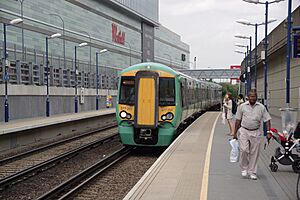
The Circle and Hammersmith & City lines share the same route here. They offer direct services south to nearby Hammersmith. North of Shepherd's Bush, these lines curve east. They go towards Latimer Road and Ladbroke Grove. Then, they go directly to important places like Paddington, King's Cross, Moorgate in the city, and the East End.
Shepherd's Bush railway station has National Rail trains. These are run by London Overground (![]() ) and Southern. You can get direct trains from Shepherd's Bush to Kensington, Clapham Junction, and Balham in southwest London. You can also go to Croydon in southeast London. Northbound Southern trains go to Wembley, Watford, Hemel Hempstead, and Milton Keynes. London Overground trains going north travel towards Willesden Junction. From there, services continue towards West Hampstead, Camden, Hackney, and Stratford in east London. This station is close to Shepherd's Bush tube station (Central line). It's on the west side of Holland Park Roundabout.
) and Southern. You can get direct trains from Shepherd's Bush to Kensington, Clapham Junction, and Balham in southwest London. You can also go to Croydon in southeast London. Northbound Southern trains go to Wembley, Watford, Hemel Hempstead, and Milton Keynes. London Overground trains going north travel towards Willesden Junction. From there, services continue towards West Hampstead, Camden, Hackney, and Stratford in east London. This station is close to Shepherd's Bush tube station (Central line). It's on the west side of Holland Park Roundabout.
Buses
Shepherd's Bush has two main bus stops. London Buses routes 31, 49, 72, 94, 95, 148, 207, 220, 228, 237, 260, 272, 283, 295, 316, 607, N72, N207, and C1 serve Shepherd's Bush Green. They also serve the south side of the Westfield shopping center. Most of these routes also stop at White City bus station. This station is on the north side of Westfield.
Cycling
There are Cycle lanes around the south edge of the Holland Park Roundabout. This is on the east side of Shepherd's Bush. These lanes let cyclists travel safely from Holland Park Avenue to Shepherd's Bush Green.
Transport for London (TfL) plans to add a cycle path. It will connect the roundabout to Cycleway 9. This cycleway is planned to run along Kensington High Street.
The Santander Cycles bicycle-sharing system is available in Shepherd's Bush. You can find docking stations near Westfield, Wood Lane station, and Shepherd's Bush Road.
Roads
The A3220/West Cross Route runs along the east side of the area. Until 2000, this road was called the M41 motorway. It was part of a plan for orbital roads in London that was never finished. Even though it's not a motorway anymore, bicycles are not allowed to use the northbound part of this road. The A3220 connects Shepherd's Bush to the A40/Westway to the north. This road has two lanes in each direction. It links the area to Paddington and Marylebone to the east. Going west, it connects to Acton and the M40 motorway. Southbound, the A3220 is called Holland Road. It links the area to Earl's Court, the A4, and Chelsea.
Other important roads in Shepherd's Bush include:
- The A219 (Wood Lane/Shepherd's Bush Road) – This road goes north to White City, Wormwood Scrubs, and Harlesden. Southbound, it goes to Hammersmith, Fulham, and Putney.
- The A402 (Goldhawk Road/Holland Park Avenue) – This road goes west to Chiswick. Eastbound, it goes to Notting Hill Gate, Marble Arch, and Oxford Street.
- The A4020 (Uxbridge Road) – This road goes west to Acton and Ealing.
Shepherd's Bush in Popular Culture
Arts and Entertainment
The junkyard in the old TV show Steptoe & Son was supposedly at 24 Oil Drum Lane, Shepherd's Bush. The popular BBC show Absolutely Fabulous often jokes about Shepherd's Bush. The main character, Edina Monsoon, owns a home here. But she prefers to say she lives in the fancier Holland Park nearby.
The BBC used to have many offices in Shepherd's Bush. Many have now closed or moved. These included the Lime Grove Studios, which were built on the site of old film studios. The BBC's main presence in Shepherd's Bush is now at two big sites on Wood Lane. These are Television Centre and the White City building. The Media Village was built next to the White City building in the mid-1980s. It's used by the BBC and other media companies. Television Centre was the main home for BBC Television. BBC TV and radio news, the BBC website, and many TV dramas and entertainment shows were broadcast from there. The BBC moved all its news operations to Broadcasting House in central London in 2012.
Shepherd's Bush Green The Green was updated in 2012–13. It was home to public sculptures called Goaloids by artist Elliott Brook. This artwork was part of the Cultural Olympiad for the London 2012 Olympic and Paralympic Games. These large, spinning football sculptures celebrated the history of Shepherd's Bush and White City. White City hosted the football games in the 1908 Summer Olympics. The London Borough of Hammersmith and Fulham is the only borough with three football teams in the Premier League.
Bush Theatre is a very famous theater for new plays. It's on the Green. It's known worldwide for finding and supporting new theater writers. It also puts on their plays to a very high standard.
Shepherd's Bush Empire is a music venue and used to be a TV studio. Many famous acts have played here, like David Bowie, Rolling Stones, and Bob Dylan. It also hosted TV shows like The Old Grey Whistle Test, Wogan, That's Life!, Crackerjack, and This Is Your Life.
Bush Hall is another, smaller, venue at 310 Uxbridge Road. It was built in 1904 as a dance hall. It mostly features smaller, acoustic music performers.
Shepherd's Bush Walkabout was a popular place for music and live sports. It was on the west end of the Green. On Australian and New Zealand holidays, and for big sports events like the Australian Football League grand final, it would get very busy. The live music was usually local bands and cover bands. They played Australian and New Zealand classic songs and popular music. Shepherd's Bush Walkabout closed in October 2013. It was announced that the site would become a hotel.
The casting agency 2020 Casting is based in Hopgood Street, near Shepherd's Bush Green. They find extras for film shoots. Classical musicians Evelyn Glennie and Robert Steadman have both lived in Shepherd's Bush.
In the Westfield shopping center area at White City, the old Dimco buildings (1898) are now a bus station. These buildings were used as the 'Acme Factory' in the 1988 film Who Framed Roger Rabbit.
Sports in Shepherd's Bush
Shepherd's Bush is home to Queens Park Rangers football club. They play their home games at Loftus Road. Olympic gold medal winner Linford Christie also grew up in Shepherd's Bush. He lived in Loftus Road as a child. A stadium on nearby Wormwood Scrubs is named the Linford Christie Stadium in his honor. Some of the football games in the 1908 Olympics were held in Shepherd's Bush. Shepherds Bush F.C. was the local football team until 1915.
Former England national rugby union team captain Lawrence Dallaglio was born in Shepherd's Bush.
The London Borough of Hammersmith and Fulham has created the Shepherd's Bush Conservation Area. This helps protect old buildings and improve the neighborhood's look.
Images for kids
-
Shepherd's Bush Market, early morning, from the Uxbridge Road end (2006)
See also
 In Spanish: Shepherd's Bush para niños
In Spanish: Shepherd's Bush para niños



